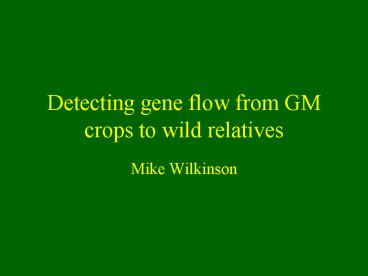Detecting gene flow from GM crops to wild relatives - PowerPoint PPT Presentation
1 / 31
Title: Detecting gene flow from GM crops to wild relatives
1
Detecting gene flow from GM crops to wild
relatives
- Mike Wilkinson
2
Interspecific hybrids between crops and wild
relatives, worldwide
Ellstrand et al. 1999
3
In the United Kingdom
- Of 30 crops reviewed
- 7 have no cross-compatible wild relatives
- 11with the potential for hybrid formation
- 12 with a history of hybridization
- From Raybould and Gray, 1993, amended by
Wilkinson 2002
4
In the United Kingdom
- First wave of GM crops
- Maize No relatives
- Oilseed rape Many relatives
- Sugar beet 1 close relative
- Potato 3 relatives, none compatible
5
The process of transgene recruitment and spread
- Initial Hybridization
- Introgression
- Gene flow between populations
- Changed fitness leading to change in population
size, density or distribution - Effects on other organisms
- Bilateral interactions(e.g. bitrophic)
- Trilateral interactions (Tritrophic)
- Changed community
6
Initial hybridization
7
Why quantify hybridization?
8
1. Hybrid frequency affects the likelihood of all
subsequent consequences
9
Example Impact
GM crop
A specialist parasitoid
10
GM crop
F1 hybrid in region
Insect resistant transgene stabilises by
introgression
Transgene spreads to most populations
Enhanced resistance to herbivore depresses
herbivore numbers
Depressed herbivore numbers depress specialist
parasitoid abundance
11
2. Hybrid abundance dictate the value of measures
to repress/prevent hybrid formation
- Isolation distance
- Male sterility
- Integration site
- Chloroplast transformation
- Inducible promotors/ terminator technology
- Transgene excision
12
Estimates of hybrid abundance and other exposure
terms have most value for regulation when applied
at national scale
13
How do you estimate F1 hybrid formation between
crop and wild relatives across the UK?
- Identify recipients
- Quantify local gene flow rates
- Estimate long-range gene flow
- Combine 1-3 to estimate frequency and location of
hybrids
14
(No Transcript)
15
Possible primary recipientsScheffler Dale
(1994) Transgenic Res. 3, 263-278
- Brassica rapa
- B. oleracea
- B. carinata
- B. juncea
- B. nigra
- B. adpressa
- Raphanus raphanistrum
- Diplotaxis erucoides
- D. muralis
16
Brassica rapa
- Casuals of disturbed land
- A weed of B. napus
- Stable wild populations of river banks
17
Weedy B. rapa in oilseed rape
18
Hybrid seed formation
- 9-93 of seeds from B. rapa are hybrids
- Average 60
- Surely lots of hybrids will be everywhere
- Jorgensen and Andersen (1994)
19
No, because
- B. rapa is an infrequent weed
- Crop rotation and weed control
20
Weedy B.rapa
In Yorkshire and the Humber region 37.4 of OSR
fields contain weedy rapa
In all other regions 0.54 of OSR fields contain
weedy rapa
21
Hybrid survival
- Hybrid seeds show lt10 dormancy
- Weedy B. rapa shows 60-90 dormancy
- So in next year, 90 of hybrids germinate but
only 10-40 of B. rapa - WEED CONTROL IS EFECTIVE IN CEREALS
- Linder (1998) Ecological Applications 8 (4)
1180-1195
22
(No Transcript)
23
Wild B. rapa
- Local hybrids
- Long-range hybrids
24
(No Transcript)
25
Screen seed offspring for hybrids
- 15341 seeds sown from two populations
- 8647 seeds germinated
- 46 hybrids morphology, flow cytometry,
chromosome counts, ISSR (0.5) - Hambledon (5m separation- 0.4)
- Culham (1m separation- 1.5)
- Wilkinson et al (2000)
26
How often do populations coincide?
27
(Wilkinson et al., 2000)
28
Sympatry Likelihood Map
29
Total hybrid number per annum
- Weed and wild hybrid numbers are now being
calculated with error estimates for the entire UK
30
Conclusions
- The number and distribution of hybrids determine
the scale, speed and possibility of any
subsequent ecological change - Hybrid numbers in a country determines the
feasibility of corrective measures - Error estimates will be fairly large initially
but can be improved - Hybrid frequency estimates should be followed by
measures of other parts of the pathway to change
31
Thoughts
- Quantification of each stage in the pathway to
change is possible but requires consideration of
location, context and biology of both crop and
recipient - Quantification requires effort to integrate data
from different disciplines - Information generated is generic for the crop in
the country concerned































